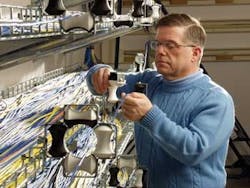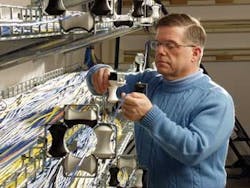A paper trail of documentation confirming performance can provide peace of mind before a reel of cable is pulled.
When you specify communications cabling, do you take for granted that it meets industry standards because it is labeled a “Category 5e” or “Category 6”? Is the jacketing marked with proper code and safety ratings? As bandwidth and transmission speeds increase exponentially and additional disparate devices are becoming attached to the same network, the need to assure that your cabling system can live up to your expectations becomes increasingly important.
Performance testing carried out by manufacturers and independent test laboratories can include the setup of cables in environments that mirror real life, such as being laid in bundles inside cable trays. This photo was taken at the Nexans Data Communications Competence Center.
Most of us accept that cables defined as “Category 6” meet the appropriate TIA-568 requirements for certain electrical parameters. Unfortunately, substandard cables are making their way into the marketplace. Some of these cables might not pass Category 3 requirements or support POTS transmission. Of even greater concern to many is that some of these cables do not meet proper fire-safety codes. Giving rise to these cables’ appearance is that some end users continue to purchase on price versus proven performance and quality.
If your installed cable plant does not meet established performance standards, or does not meet proper codes, the results can be extremely costly. The best way to assure that the cable being specified and installed meets such specifications is to look at the paper trail on the particular cable. In other words, look at its “pedigree.” You can do this by carefully examining the manufacturer’s data sheets and testing results from credible independent testing labs.
For safety’s sake
The primary reasons to assure that communications cables meet their specified ratings are for public safety and to avoid any potential liability issues. Secondary is that the installed cables meet minimum standards for both physical and electrical performance, or the network could fail and cause costly downtime. Replacing cable is very low on any network manager’s list of desirable activities, but if the cable is not deemed safe or does not meet performance specifications, it could have costly repercussions.
Over the years a number of fire safety standards for data communications cable have evolved in North America and the European Union. The standards that dominate data communications cable fire testing are described in the National Electrical Code (NEC) administered by the National Fire Protection Agency (NFPA; www.nfpa.org); the Canadian Standards Association (CSA; www.csa.ca) fire test standards, and through European standards EN50266 Common Test Methods for Cables Under Fire Conditions; and IEC 60332-3 Tests on Electrical and Optical Fibre Cables Under Fire Conditions.
The NEC contains articles that cover specific types of premises cabling installed in buildings, and cables must pass Underwriters Laboratories/NFPA flame tests to comply with these codes. When a cable passes these stringent tests, the legend on the cable jacket and on the box should be marked with the proper rating.
Recently the Communications Cable and Connectivity Association (CCCA; www.cccassoc.org), of which Berk-Tek is a member, released results of eight Category 5e and Category 6 cable samples it tested after purchasing those cables through distribution. None of the cables were made in North America, but were being distributed on this continent.
The tests were a follow-up to similar tests the association conducted in 2008, in which it found eight of nine cables failed to meet fire-safety requirements. In the more recent testing, the CCCA found that four of the five companies that failed in 2008, failed again. According to CCCA executive director Frank Peri, “The failing products were made with inferior materials and designs to save on production costs and they predictably failed the minimum fire safety requirements. Our association is cooperating with major independent telecommunications industry testing agencies to establish a stronger approach to assure compliance with safety standards.”
In addition to failing fire-safety tests, three of the eight cables tested failed to comply with minimum electrical performance requirements for Category 5e or Category 6, for which these cables claimed independent test certifications.
Third-party testing
Third-party laboratories offer testing of products as well as monitoring of manufacturing processes. These services help assure product reliability, safety, and consistent quality, consequently offering peace of mind and return on investment for the end user and the contractor. Under these third-party programs, random samples of products are selected independently by the lab or submitted from the participants to be inspected and tested for their conformity to the applicable test standard.
Third-party labs incorporate industry-specific test methods to evaluate, inspect, verify, and document. Third-party labs are recognized by the Occupational Safety and Health Administration (OSHA; www.osha.gov) as Nationally Recognized Test Laboratories (NRTLs), and are further accredited by one or more organizations such as the American National Standards Institute (ANSI; www.ansi.org), the Federal Communications Commission (FCC; www.fcc.gov), the National Institute of Standards and Technology (NIST; www.nist.gov), and the American Association for Laboratory Accreditation (A2LA; www.a2la.org) to be able to test to standards that provide for verification and safety marks.
Verification and safety marks are based on standards published by organizations like Underwriters Laboratories (UL; www.ul.com), the Telecommunications Industry Association (TIA; www.tiaonline.org), the International Electrotechnical Commission (IEC; www.iec.ch), and the International Organization for Standardization (ISO; www.iso.org). In addition to product testing, third-party testing labs offer facility and manufacturing inspections as well as ongoing follow-up testing of randomly selected samples.
Product failures can result in product disqualification unless corrections are made by the manufacturer and retesting is performed. A verification or certification mark by an approved third-party lab allows the manufacturer to label its products as compliant and assures the customer that the products they purchase meet the manufacturers’ specifications.
Verification testing
One of the most valuable testing programs is verification testing. It can be requested from manufacturers, suppliers, or end users. Initial qualification of cable usually includes verification through a network analyzer performed by a third-party test lab that will authenticate that the cable meets or exceeds the industry standards. “The first step to any verification testing and product qualification is to use the industry standards called out in the TIA or ISO to level the playing field and define the parameters or characteristics to be tested,” explains Vicki Stafford, account manager with independent test lab Intertek (www.intertek.com).
Network analyzers, the most sophisticated test instruments used in our industry, offer extremely accurate results in a lab-test environment. Both TIA and ISO standards recognize this tester to produce exact results through mathematics and ongoing calibration. “For testing the cable and the entire channel, there are procedures within the network analyzer that exclude the effect of the interconnecting cables and connectors located between the analyzer and the device under test, so that only the device under test is precisely and accurately measured,” explains Antoine Pelletier, datacom engineer at Intertek. The ETL Listed mark, provided by Intertek, is proof of product compliance (electrical, gas, and other safety standards) to North American and international performance standards.
Some companies provide their own specifications and set higher limits than those stated by industry standards. “The flexibility at Intertek allows us to focus on our client’s unique products and their relative testing needs,” Pelletier further explains. “As a global testing services provider we welcome opportunities to offer proprietary testing.”
Berk-Tek used this capability from Intertek to have its Category 5e, 6, and 6A cables tested to levels above those spelled out in standards for performance characteristics such as crosstalk. Intertek maintains a Directory of ETL Verified and ETL Listed Cabling Products, which is available at its Web site. Some cabling-product manufacturers also include ETL test reports for their products on their respective Web sites.
Reputable testing labs test to UL, ANSI, CSA, ASTM, and NFPA standards. Authorities having jurisdiction (AHJs) in the 50 United States and in Canada, as well as retailers, accept the ETL Listed mark as proof of product testing and verification. However, in order to allow the use of the “verified” mark, qualifying companies agree to ongoing testing on a quarterly basis so that the facility is monitored and random samples continuously tested.
“Quarterly unannounced visits to the manufacturing site include inspection and comparison of the verified product against drawings, bill of materials, and test reports to determine that the produced units are the same as the sample subjected to the qualification tests,” Stafford explains. “In addition, an audit on the quality control program includes detailed review of the company’s inspection of produced material, manufacturing quality control methods, equipment calibration and maintenance, final inspection and testing, product handling, packaging, and storing as well as a corresponding and corrective action program and an analysis of field performance data.”
Through the efforts of watchdog groups and third-party testing, end users can be assured the cable products they specify and install are certified to perform as advertised as well as provide assurance of safety and quality. There are reputable manufacturers whose cables adhere to codes and standards; those products are available in a competitive marketplace.
The difficulty is knowing how to tell them apart. Do not rely solely on the cable legend. Always ask for proper documentation and the “paper trail,” or the results can be very costly.
Carol Everett Oliver, RCDD/ESS Specialist is marketing analyst with Berk-Tek, a Nexans Company (www.berktek.com).

